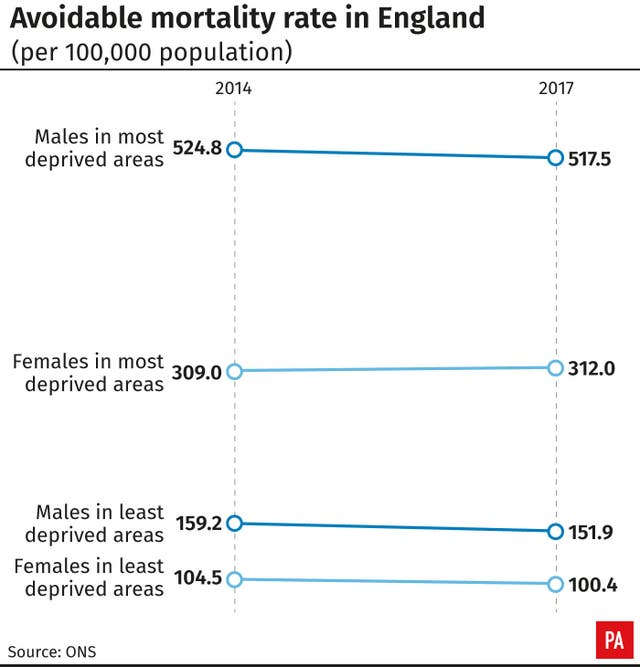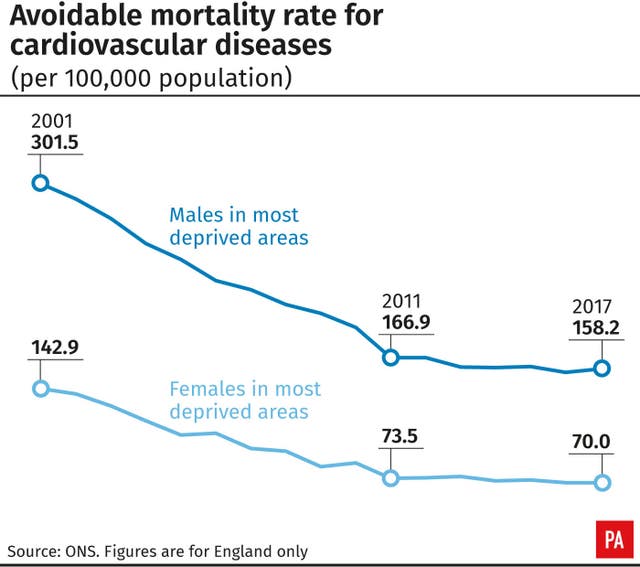
Men living in the poorest parts of England are 4.5 times more likely to die from an avoidable cause than those in the richest areas, new figures suggest.
Avoidable deaths – those which could be prevented through timely and effective care or public health interventions – were 3.9 times more likely among women in the most deprived areas, the Office for National Statistics (ONS) data also shows.
Charity the Health Foundation described the difference as “astonishing” and called for action to tackle poverty.
A total of 16% of avoidable deaths in men were among those living in the poorest areas, the data from 2017 shows.
This compares to 6% in the richest areas.
Among women, this percentage was 14% for those in the most deprived areas and 7% for those in the least.

Jo Bibby, director of health at the Health Foundation, said: “When looking at the causes of preventable deaths, it is easy to blame the individual and focus on how things like smoking, drinking, lack of exercise or poor diet can contribute to disease.
“But doing so fails to recognise that the conditions in which people live, work and age can make it harder for people to live healthier lives and in turn drive these huge differences in avoidable deaths.
“To reduce deaths from preventable diseases, we need cross-government, cross-sector action ranging from tackling poverty to investing sufficiently in local authorities to create the circumstances that enable everyone to live a healthy life.
“The NHS also has an important role to play to ensure that every person in the UK has equitable access to health care and that primary care, which plays a critical role in preventing and treating ill health, is properly resourced – particularly in areas of high deprivation.”

Avoidable mortality rates for cardiovascular disease reduced among men and women between 2001 and 2017, the ONS figures show, but progress appears to have slowed since 2011 across all levels of deprivation.
The gap between the most and least deprived areas decreased by 40% for men and 43% for women across this 17-year period.
Meanwhile, between 2011 and 2017, avoidable deaths from injuries in England increased by 16% among females and 17% among males in the most deprived areas.


Why are you making commenting on The National only available to subscribers?
We know there are thousands of National readers who want to debate, argue and go back and forth in the comments section of our stories. We’ve got the most informed readers in Scotland, asking each other the big questions about the future of our country.
Unfortunately, though, these important debates are being spoiled by a vocal minority of trolls who aren’t really interested in the issues, try to derail the conversations, register under fake names, and post vile abuse.
So that’s why we’ve decided to make the ability to comment only available to our paying subscribers. That way, all the trolls who post abuse on our website will have to pay if they want to join the debate – and risk a permanent ban from the account that they subscribe with.
The conversation will go back to what it should be about – people who care passionately about the issues, but disagree constructively on what we should do about them. Let’s get that debate started!
Callum Baird, Editor of The National
Comments: Our rules
We want our comments to be a lively and valuable part of our community - a place where readers can debate and engage with the most important local issues. The ability to comment on our stories is a privilege, not a right, however, and that privilege may be withdrawn if it is abused or misused.
Please report any comments that break our rules.
Read the rules here